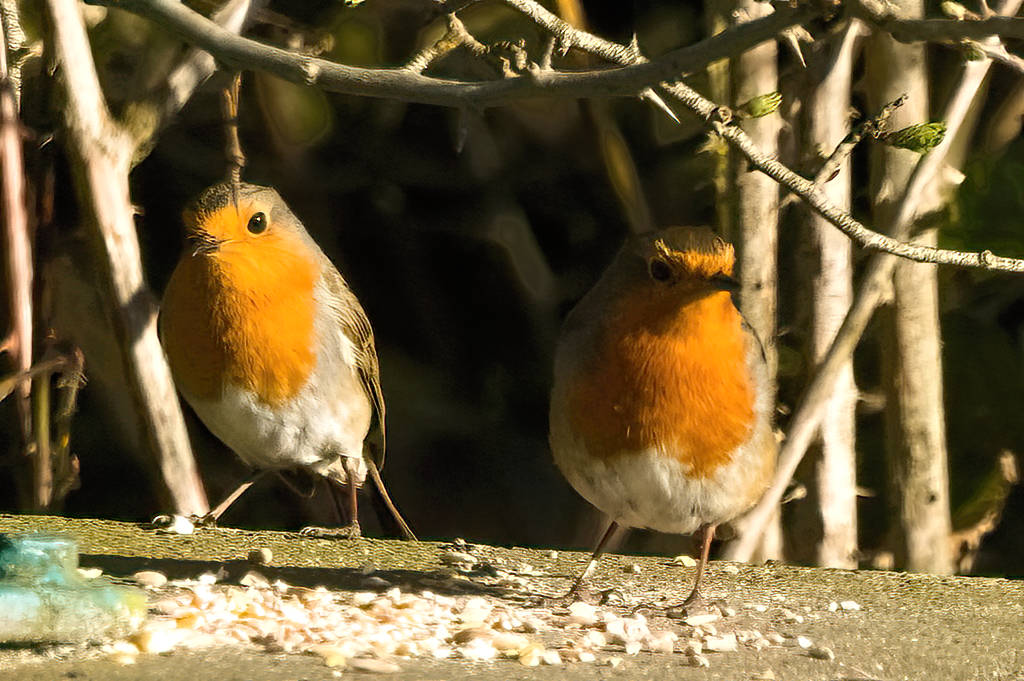Robin photographs were a major part of “My Little Bird Books No.1 – Robin Redbreast” and this is a kind of supplement to the book with a few of the bird photos taken since the book was finalised. I thought also that, although this blog is meant to be more about the birds themselves than about bird photography, it might be good to add a few comments about when the photos were taken.
The image above comes from a walk along the local cycle path. This Robin flew across just a few yards from me and, instead of hurrying into the bushes, perched right in full view. He allowed me to approach nearer and nearer, repeatedly taking photographs, until for this one I was only about six feet away, the bird almost filling the camera viewfinder. He seemed totally unafraid of a human coming up close, not at all camera-shy, a great example of the “friendly” Robin. Then a man with a dog walked past and away went Robin.

I was staying for a few days with some of my family in Yorkshire and watching the birds near their garden feeders.The Robin in the photo above would fly out to the feeder, take something and immediately return to the hedge and hide.
Telling male and female apart is very difficult but I liked to think that this was an adult male and wondered whether he might be feeding his mate (male Robins do that in Spring) but there didn’t appear to be another bird present. Erithacus rubecula, the European Robin (American robins are a totally different species) is known for being confident among humans, not shy although cautious, but this one was reclusive There seemed little likelihood of my being able to get robin photographs today.
Then I realised that if I stood well back by the side of the house there was a slight gap in the foliage through which I might be able to see him clearly. My 400mm zoom lens proved sufficient and after a few failures I managed to get this shot. It’s far from perfect but at least I could show the family a picture of their garden Robin.

Here’s another example of a photo taken through a gap in the branches of a bush. With a long lens such as my Tamron 18-400 mm zoom it is often, though by no means always, possible to peer through small gaps between the brown and green which at first sight seem to hide the bird completely.
Once again I was walking along a path when a Robin flew across immediately in front of me. He (or she?) landed briefly on the grass, picked up something and immediately flew into the nearest bush. As with the previous photo I had to decide how to get a clear line of sight through the branches.
It wasn’t easy. The bird was moving a little, and taking several shots in rapid succession seemed to be the best tactic. I was fortunate with this one. A twig does cut across the front of his face but it leaves his eye, his bill and his caterpillar in clear view. He then disappeared deep into the bush. Sometimes all that one can do is take a series of shots and hope that one of them turns out alright. Robin photographs, just as with other birds, can be rather unpredictable. This time it worked.

Two for the price of one. Someone had left bird food on the top of the low wall of an old disused railway bridge. It attracted this Robin pair out together. How can you tell a male robin from a female? The answer is that it’s quite difficult. Why do I think these two are a pair? Well at this time of year if they weren’t they’d have been fighting. Protecting one’s territory is vital, as I explain in the “Robin Redbreast” book, and when food is short in Winter that even includes chasing off some other birds such as Dunnocks.
Since that day I’ve been back to this spot several times in the hope of seeing them together again, but have only found one at a time. Quite probably Mrs. Robin is more concerned at present with looking after her eggs.
More Robin Photographs
If you haven’t already got a copy, click here TO BUY Robin Redbreast, No.1 in my new series, “My Little Bird Books”. In just 36 pages it is packed with robin photographs and contains a lot more interesting information about these attractive birds, finishing with a crossword puzzle. The book is, of course, about the British bird, the European Robin. American Robins are different, more the size of a Blackbird and differently coloured.





Well done David. Miss your preaching!
Thank you, Philip. And I miss being in your part of the world. At one time it looked as though I might return but it wasn’t to be. However, I hope to see you in the Summer.